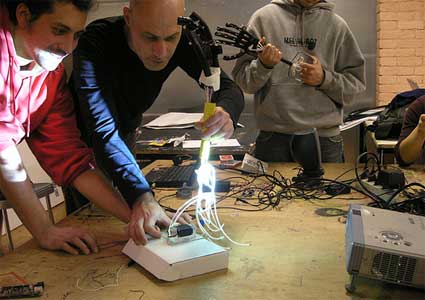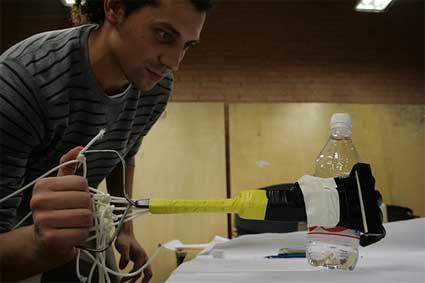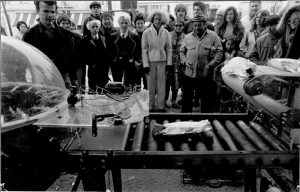Yaniv Steiner has been running a class at the Visual and Multimedia Design graduate programme from the University of Architecture in Venice a few weeks ago. Its approach was slightly different from classical physical computing classes, starting with the name of the class: Usable Witchery. Students learned magic tricks with coins and cards, and then built up some Animatronics elements trying to humanize machine and robots to look and feel more like humans.

I’m just going to give a summary of the course as i feel its spirit might be relevant to the interests of many readers. But i’ll keep it short as i’ve decided a while ago not to cover anything i haven’t had the opportunity to see nor experience myself. Rules are supposed to have exceptions, right?
Usable Witchery investigated how products could be less a result of technical thinking, and become more “humanized”, natural and intuitive. As Yaniv told me recently: “I will trade many functional elements to magical and slightly more poetical element in any of my devices. I hope the student will apply it one day as they go and work for IDEO and Nintendo J.”
 Image by Yaniv Steiner
Image by Yaniv Steiner
He explains with further details this association between magic and interaction design in a list of reasons why advanced technology can be compared to magic. According to him, interfaces are actually doing the same to some extent. His text illustrates the point by giving examples of interaction procedures, viewed from this frame of reference: calculators displaying, without revealing how, the correct series of digits, mountains of information “leaping” invisibly in the air, “hold” switches, etc.
But still… Harry Pottering design students?
“Regarding the coin tricks, think about it as a mean of presentation, a critical presentation that can go only two ways, good and enjoyable or simply fail,” explains Yaniv. “Once a successful magic been produced, the observer appreciate the illusion, sometimes even on the emotional level. While learning sleight of hand tricks and practicing the art on the physical level, one can theoretically apply this art into other fields, interaction/interface design is just one of them.”
“Regarding the animatronics part, I feel it is dealing with humanization of machines in relation to Physical-Computing,” he goes on. “We all saw the blinking LED – Blink; and how motors can move robotic limbs with the grace of “Marvin the paranoid android”. We conducted experiments with ways to humanize these artifacts, making them closer to the way we, humans, interact and communicate with the world around us. And thus giving a small humanized illusion.”
 Image by Synodic Month
Image by Synodic Month
Tons of images from Usable Witchery.
Related entries: Yaniv Steiner’s talk on rapid prototyping process and Opensourcery (where Zach Lieberman learns a few tricks from Mago Julián.)







